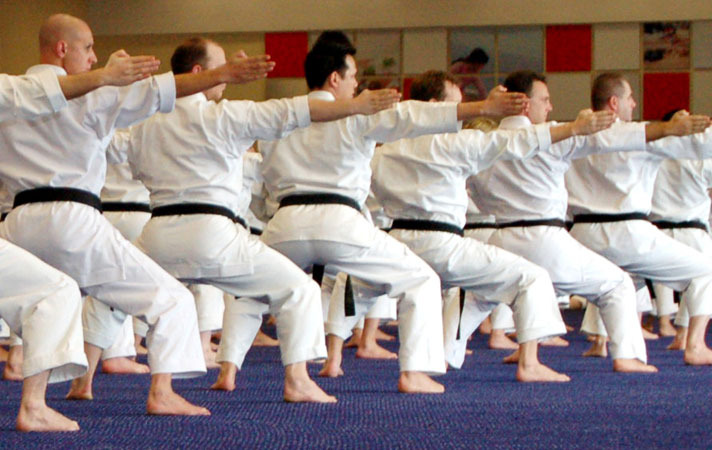Playing Through Arthritis
Whether its running, swimming, aerobics, football, karate of course, people are more active today than ever before. However, you may be one of those people who have to limit their activity because of the pain and stiffness of arthritis.
Experts predict that within the next 20 years, one in four people in the Western World will suffer from arthritis. Why is arthritis so common? What causes it? How can we prevent it and how can we alleviate its toll on our body? Before beginning, let us examine the two primary types of arthritis.
Rheumatoid arthritis
- Causes severe swelling of the joints and morning stiffness and tends to be equal on both sides of the body. It mostly affects women and usually strikes in the small joints of the hand.
Osteoarthritis
- (Not to be confused with osteoporosis – ‘brittle bone disease’) is the most common form of arthritis. The term ‘osteo’ means bone, however, it is not a disease of the bone until its more advanced stages. It primarily affects people over the age of forty and can affect almost any joint of the body, including the knee, hip, spine, and neck. It can affect people in a sporadic fashion and tends to be present in areas where injury has occurred. The most common symptoms are pain and stiffness. The major risk factors for developing osteoarthritis are Trauma to a joint or surrounding structures, age (over forty), genetic predisposition, excessive weight, being female and nerve damage.
How Osteoarthritis Occurs?
A joint is comprised of several structures. It is lined with synovium, a membrane that produces nutrients for the joints, and produces synovial fluid, which lubricates the joint. The surfaces of joints are lined with cartilage, which is made mostly of water and matrix (a collection of collagen and various molecules). Cartilage allows the joint to absorb enormous amounts of force, yet maintain stiffness and prevent injury. However, it has no nerve endings or blood supply so it relies on synovium for its nutrients.
The development of osteoarthritis can occur in any area of the joint. When there is a disassociation between the synovium and cartilage, the cartilage receives no nutrients and becomes susceptible to injury and impaired healing. When cartilage is injured directly, it tries to self-repair by increasing production of the matrix. Unfortunately, when osteoarthritis is present, the cells also produce enzymes that lead to the destruction of cartilage. Over many years the cartilage, which is normally extremely smooth to allow a joint to move freely and slide effortlessly a thousand times per day, begins to roughen and wear. The synovium thickens and becomes inflamed. Without intervention, the destruction of cartilage continues unabated and the symptoms worsen. Starting with mild pain in the joints, they escalate until one day it is difficult to perform everyday activities.
It is relevant to note; as cartilage has no nerve endings, the pain you feel comes from bone spurs, synovium and surrounding muscles, tendons and ligaments. While osteoarthritis is the destruction of cartilage, it is actually the changes in all of the surrounding structures that lead to the pain. This is why exercise, strength, and flexibility play major roles in its healing, but we will extend on that later.
People who have osteoarthritis in one joint are likely to have other joints affected. Just as the old song says, “The knee bone’s connected to the hip bone”. When one joint hurt, you walk differently, which puts abnormal pressure on other muscles and joints as they compensate. Therefore recognizing it in its early stages can help you avoid the domino effect. As mentioned earlier, joint damage is the most common trigger. That said, it does not have to be a major sporting or motor accident. Many injuries occur through micro-damage. For example, years of standing poorly (with one leg taking all the weight) can lead to tiny tears in the spinal joints, which over time, grow to become injuries. The best game plan for preventing arthritis is to exercise appropriately and maintain an ideal body weight.
Winning The War On Arthritis
More than half the sufferers of arthritis do not see a doctor. In lieu of their pain, it is felt that nothing can be done about it, and they are doomed to a life of pain that will grow more intolerable as the years wane. Nothing could be further from the truth, because living with the pain of arthritis is not inevitable. There are four valuable methods of dealing with or even preventing arthritis. These are Exercise, Diet, Medicine and Alternative Therapies.
Exercise: As you know, osteoarthritis is a disease of the joints – specifically cartilage. So how can exercise help your cartilage? When joints move, muscles, ligaments, and tendons control the movement. All the structures move in unison allowing for easy motion. When a joint develops osteoarthritis, it is moved less and in a narrower range of motion. This causes muscles to become weaker and lose flexibility. As the muscles get weaker, the joint is exposed to greater forces and the muscles are less able to absorb some of the shocks. The joint now becomes more prone to damage and hurts more as you use it. A negative feedback cycle is set up as the pain causes you to avoid exercise so the symptoms continue to escalate.
The most obvious example of this is the knee. Numerous studies have shown that the amount of damage caused by arthritis (as shown on x-ray) does not accurately indicate a person’s pain level. This is because the amount of pain felt is dictated not by the level of injury, but by the quadriceps muscle (found in the front part of the thigh). This muscle is responsible for slowing the leg down against gravity as you plant your foot down while walking. When the quadriceps is weak, the foot hits the ground with a greater force and the force is transmitted to the knee.
On the contrary, let’s assume your quadriceps is strong. When you walk or run, far less force is transmitted to the knee. Therefore, you are far less likely to develop damaged cartilage. Or, if you already have arthritis, less force means less pain, allowing you to go farther and faster. Studies show that patients with arthritis can reduce pain by 50% within 6 weeks on a quadriceps strength program.
The strength component to exercise is only one part in its fight on arthritis. As part of the negative cycle people fall into, when you are inactive and have arthritis, the body produces less synovial fluid (the joint’s natural lubricant). This makes it more difficult and painful to move the joint. Exercise helps to stimulate the replenishment of synovial fluid. With increased strength and an increase in lubricant around the joint, the pain of arthritis is minimized and the further decay of the joint postponed.
The challenge of exercise with existing sufferers of arthritis is that for the initial period, you may feel discomfort and be discouraged. It is important to work up at an easy pace and have faith that you are doing your body a service. It is also essential you warm up properly beforehand. One of the main factors leading to injury, thus triggering arthritis is lack of mobility. When muscles, tendons, and joints are not sufficiently stretched out, they are more prone to injury (micro or immediate).
Diet: By maintaining an ideal body weight, you decrease the risk of developing or worsening arthritis. Equally, eating healthy stimulates the muscle, synovial fluid and enzyme production. All of these can either minimize or prevent arthritis.
Medicine: This can often be a necessary and incredibly helpful tool in overcoming the pain of arthritis. One should never hesitate to see their doctor for information on the various treatments. These include creams, drugs, pain medications, surgery, tetracycline antibiotics, heat and cold home therapies etc.
Alternative therapies: The following is some helpful information relating to the most common natural arthritis therapies.
Ginger has been used by the Chinese as a cure for many ailments for over 2000 years. It has been proved to help as a digestive aid, an anti-nausea medication pain reliever and anti-inflammatory. Ginger may, therefore, work by decreasing some of the inflammation and improving blood flow to your joints by acting as a natural blood thinner. It can also relieve the pain and stiffness of arthritis. Even if not effective in every case, it makes a healthy food that adds flavor to your dishes. Ginger has been shown to be more effective in the treatment of arthritis when taken alongside ‘Turmeric’ (curcumin) and ‘Boswellia’ (both proven anti-inflammatory herbs).
Bromelain is a protein-digesting enzyme found in pineapples. It is believed to be a natural remedy that works the same way that NSAID’s or COX-2 inhibitors work by reducing the number of prostaglandins. It is also believed to reduce the activity of fibrin, which is involved in the formation of blood clots. Studies found it can reduce the pain in most arthritis patients.
Cartilage And Collagen. Many products containing natural sources of these have been touted as reducing inflammation and possibly repairing joint damage. These include such things as shark cartilage and chicken collagen. Unfortunately, scientific basis does not appear to be solid.
Sulfur Compounds became popularised in the early part of 1999. The theory was that the arthritis sufferer’s joints were shown to be much lower in sulfur, therefore, by replenishing the sulfur component, one could decrease the rate of cartilage breakdown. While sales skyrocketed, and there are people testifying that it was their miracle cure, there have still been no studies able to prove it works at all. Either way, garlic is high in sulfur and is excellent for inner health. So were arthritis sufferers to increase their garlic intake, even if the sulfur did very little, it would still keep them in good health. Magnet therapy has been around for years but is on the increase. The theory is that the body is made up of billions of magnetic charges and when these charges are out of alignment, cells do not function properly, leading to disease and arthritis. By applying magnets, a person can realign the charges, nervous system impulses and blood flow. Some also claim that magnets dissolve calcium deposits in joints. All these theories are sketchy at best, although two small studies have shown that magnet therapies do manage to diminish pain. Considering some products charge large sums or money, they are not the advised method for helping arthritis. If your arthritis prevents you sleeping, it is best to only buy a ‘magnet mattress’ if you are able to try it out for some time first.
Glucosamine And Chondroitin are the two most popular therapies. They are natural constituents of cartilage, so it is thought that by taking these building blocks of cartilage, they will stimulate other cartilage to regrow, reversing the process of arthritis. This theory had many skeptics as most believed they would be broken down by stomach acids before reaching the joints. However, it was discovered that up to 70% actually reaches the joints. Does this fact mean they work? Not necessarily, but it is a start. Skeptics were also concerned as they take effect in 2-3 months; a period way too short to restore damaged cartilage. So perhaps it was the placebo effect. Again, this theory was cast aside after many studies comparing patients taking the supplements and patients taking placebos. It was found, not only did those taking the supplements to experience less pain but lost no cartilage during the study, while placebo takers lost an average one-sixth of an inch per year. To date, not a single study has been able to show these supplements can regrow your cartilage or reverse the effects of arthritis. But it does seem rather evident hitherto, that they can prevent the further loss of cartilage. In fact, it is suggested that all people, especially those overweight, who exercise take these supplements to aid in avoiding osteoarthritis.
Glucosamine and Chondroitin are the two most popular therapies
Experts from the book ‘Playing Through Arthritis’, by David S Silver, M.D




